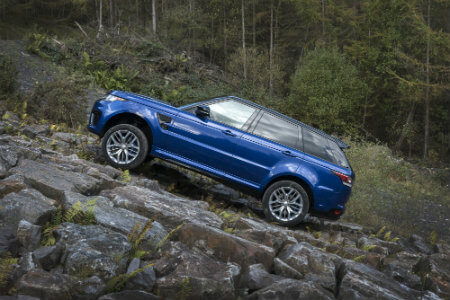
Land Rover’s are often the first off-road vehicle people think about. These vehicles are great for all environments whether it be forests, deserts, mountains or even a frozen river.
They come with a Terrain Response system and there are five different programmes: normal driving, grass/gravel/snow, mud and ruts, sand and rock crawl.
Mud and Ruts
When driving in deep mud a steady momentum is needed, and you can use the Mud and Ruts Terrain Response. Using a low gear is advised. The tyres will cut through the heavy mud and will find traction on firmer ground below the mud. Land Rover’s all come with built-in Traction Control and this sends power to the wheels that have the most traction.
The wheels will usually spin in thick mud, if this happens ease off the throttle and slow down the tyres, which should regain their grip. If there are deep ruts, straddle them as this lessens impact on the environment. Also keep the lowest point of the vehicle clear of the ground. Terrain Response will automatically keep the vehicle to an appropriate height.
Sandy Conditions
When driving across sand a low gear is needed and a steady momentum must be attained, just like then you play games of skill or chance at River Belle Casino. A lower tyre pressure can create a larger surface area. The sand Terrain Response can be engaged.
There is also the chance of spinning wheels and easing off the throttle and slowing the tyres should regain tyre traction. If the sand is wet, the Mud and Ruts Terrain Response is best in this instance.
Try to avoid wet sand if possible as it may be quicksand or ‘floating’ sand which is very dangerous. Always park on a downward slope if need be as it is easier to pull away. If you find yourself in a sandstorm you should turn the vehicle facing the wind and turn off the engine until the storm passes.
Rocky Terrain
When encountering rocky terrain first assess the risks before proceeding. Once the route has been assessed you can choose the Rock Crawl Terrain Response. Using a low-range first gear is advisable for rocky terrain.
Before driving on uneven terrain make sure everything in the vehicle is secure such as items on a roof rack. A low gear should be used. Look out for large rocks or potholes that could unbalance the vehicle. Always approach rocky steps, ditches or logs at a diagonal angle, and always have three wheels on the ground all the time.
Water
When driving through water first assess how deep the water is. Drive through very slowly and then build up momentum as you drive.
Make sure not to slip or ride the clutch, as this will reduce control. Once you have reached the other side, ease off the accelerator.
Icy Surfaces
Icy surfaces require the Grass/Gravel/Snow Response and use a high gear. Momentum should be steady and the wheels must be kept rolling. The built-in traction control will drive power to the wheels.
If the wheels spin or slide ease off the accelerator until the tyres regain their grip. Do not brake too quickly as this can result in slipping.
